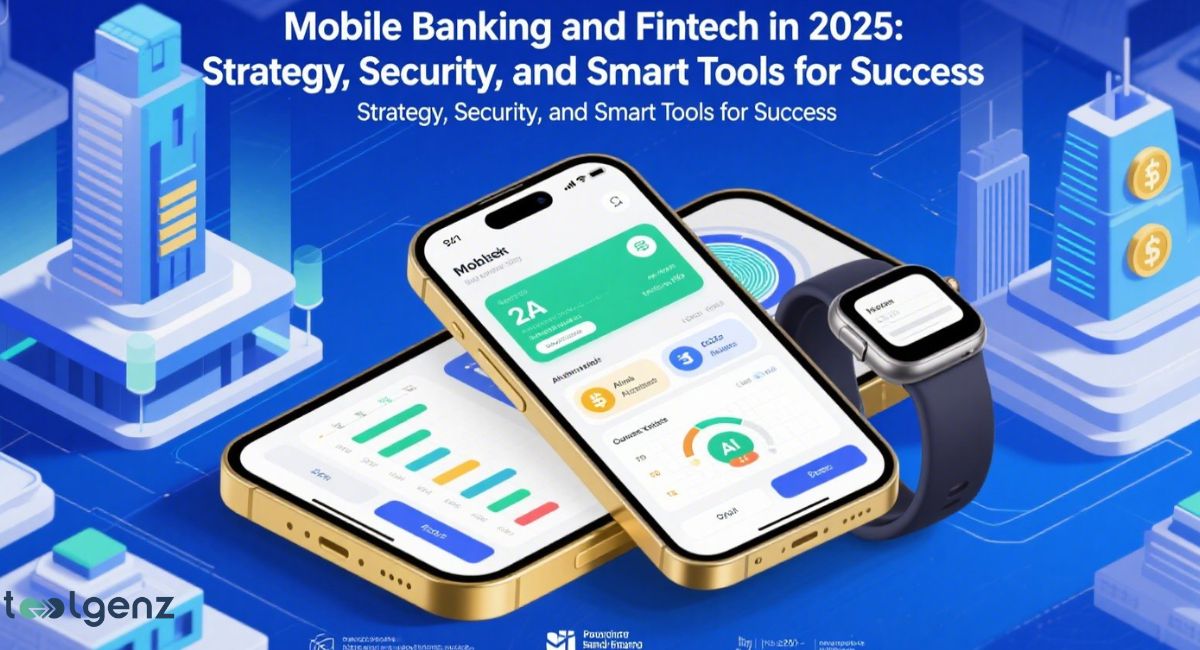In 2025, mobile banking and financial technology (Fintech) are transforming how people and businesses manage money.
With faster apps, smarter tools, and more secure systems, digital banking is no longer a luxury—it’s a necessity.
From instant money transfers to real-time banking access, users now expect everything at their fingertips. Banks and fintech companies must keep up by offering flexible solutions, strong online banking security, and easy access to services.
This guide explores the newest mobile banking strategies, security trends, top apps, and smart tools shaping finance today.
Whether you’re a beginner or a business leader, it’s time to unlock the full potential of mobile banking and fintech in 2025.
As mobile banking continues to evolve, innovations like biometric authentication, AI-powered financial advisors, and blockchain-based transactions are becoming mainstream.
These advancements not only enhance convenience but also reinforce trust and transparency between users and financial institutions. Staying informed and adapting to these trends will be key to thriving in the digital finance landscape of 2025.
What is Mobile Banking and How It’s Changing Finance in 2025
What is mobile banking? It means using your phone to manage money. In 2025, this is more advanced than ever. You can send money, check balances, pay bills, and even apply for loans using mobile banking apps.
This shift is part of a big change in digital banking, where traditional banks now offer real-time banking access and better features to meet customer needs.
With embedded finance and smarter AI tools, mobile banking is now part of our daily lives. Banks no longer just store money.
They now give advice, alerts, and tools to track spending. This is helping more people, including small businesses, manage money without visiting a branch.
Mobile banking apps also offer personalized financial insights based on your spending habits, making budgeting easier than before.
Plus, features like instant notifications and fraud detection provide added security and peace of mind, making mobile banking both convenient and safe for everyone.
Top Benefits of Mobile Banking for Consumers and Businesses
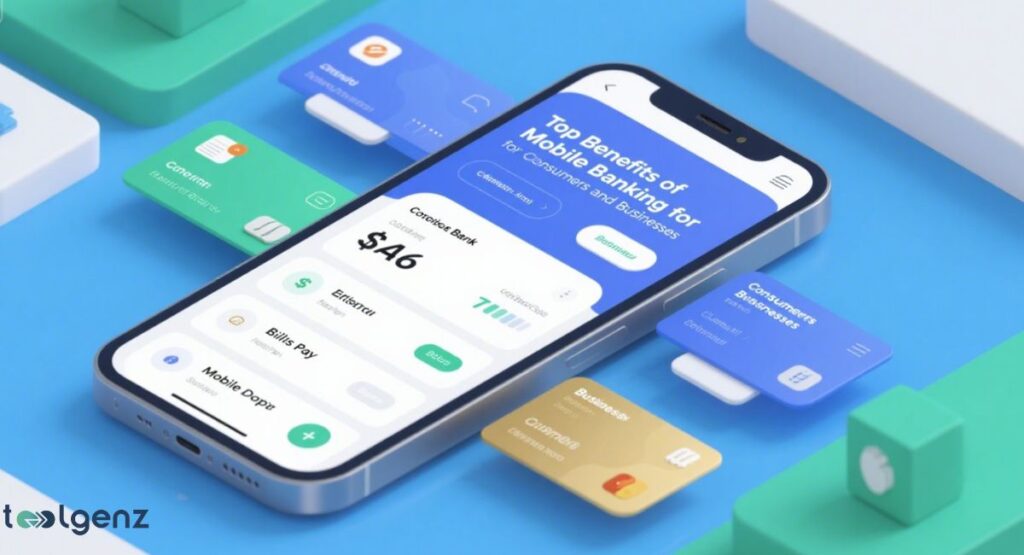
The benefits of mobile banking are many. First, it saves time. No more standing in long lines.
You can transfer money or pay bills from anywhere. Second, it gives better control. With mobile account monitoring, you can watch your budget and set limits easily.
Third, it’s more affordable. Some banks offer zero-fee accounts and banking rewards programs for mobile users.
For businesses, mobile banking means faster payments, easier payroll, and tools for planning.
Many small and medium businesses (SMEs) use mobile finance tools to track cash flow and make real-time decisions. These tools also offer privacy banking features, which are very important in today’s data-driven world.
Additionally, mobile banking enhances financial inclusion by reaching unbanked or underbanked populations, giving more people access to essential financial services.
The convenience of 24/7 availability combined with advanced security protocols ensures that users can confidently manage their finances anytime, anywhere.
This blend of accessibility, efficiency, and security is driving the widespread adoption of mobile banking worldwide.
If you’re looking to take budgeting even further, platforms like GoMyFinance offer tailored insights and tools for managing money smarter.
Explore our complete review of GoMyFinance’s smart budgeting features to see how it can complement your mobile banking experience.
Mobile Banking Strategy: Planning for User-Centered Digital Growth
A strong mobile banking strategy focuses on what users need most. In 2025, banks and fintech companies work hard to create apps that are easy to use, fast, and safe.
They use real-time data in banking to offer better services, such as alerts for low balances or spending trends.
Mobile banking strategy tips include using clear app designs, adding AI chat support, and offering personalized help. Banks also partner with other services to offer more features inside one app.
These super-apps in fintech help users do more without switching apps. This makes banking simpler and smarter.
Moreover, incorporating advanced security measures like biometric authentication and multi-factor verification is essential to protect user data and build trust.
Emphasizing seamless integration with payment platforms and digital wallets also enhances the user experience, allowing effortless transactions and greater flexibility.
A customer-centric approach, combined with ongoing feedback loops, ensures that mobile banking solutions evolve to meet changing user expectations and technological advancements.
Creating Your Mobile Banking Plan: Tools, Features, and Compliance
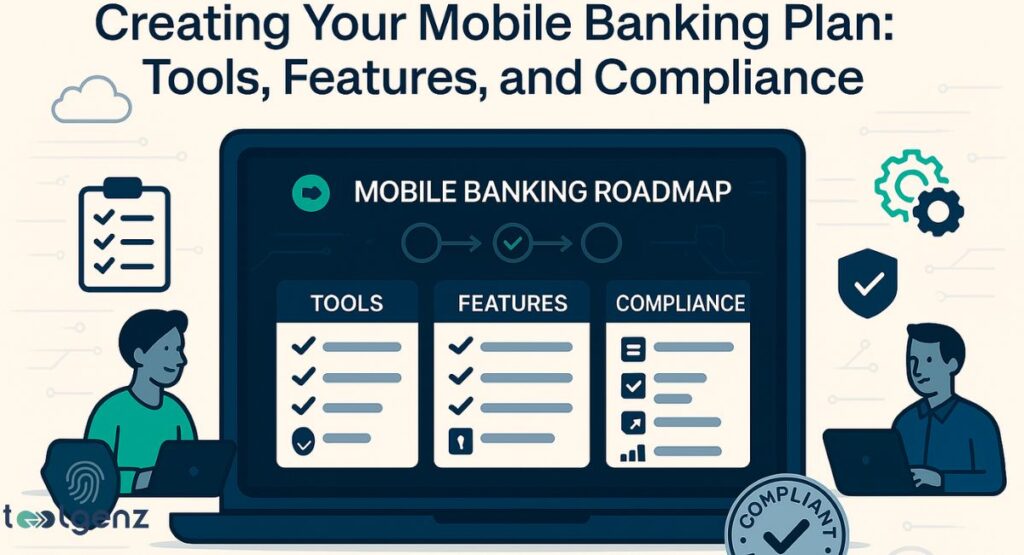
How to create a mobile banking plan starts with your goals. Do you want to save more? Track spending? Send money faster? Knowing what you need helps you pick the right tools.
Look for mobile budget planning, savings trackers, and instant money transfer features.
It’s also important to check for two-factor authentication and biometric authentication to stay safe. If you’re a business, make sure your bank follows rules for safety and user data.
Having a strong plan means using the right mix of tools and choosing a secure banking app that works for your needs.
Additionally, consider the level of customer support available, such as 24/7 chat or phone assistance, to help resolve issues quickly.
Evaluate whether the app integrates well with your existing financial tools or accounting software, especially for business users.
Regularly review your plan and update it as your financial situation or goals change to stay on top of your money management.
Top Cybersecurity Risks in Mobile Banking and How to Stay Safe
There are many cybersecurity risks in mobile banking. Hackers may try to steal login data or send fake links. Using public Wi-Fi can also be risky.
That’s why banks now use stronger protections. One key feature is two-factor authentication, which adds a second step to the login process.
Another is biometric authentication, like fingerprint or face unlock. To stay safe, update your apps often, don’t share passwords, and use alerts for any strange activity.
Learning how to secure your bank app is one of the most important things in mobile banking today.
Additionally, be cautious of phishing attempts—never click on suspicious links or provide personal info to unknown sources. Use a trusted VPN when accessing banking apps over public networks to encrypt your data.
Regularly monitor your account statements for unauthorized transactions and report any suspicious activity immediately to your bank. Staying vigilant is key to protecting your financial information.
Best Mobile Banking Apps in 2025: Features, Security, and User Reviews
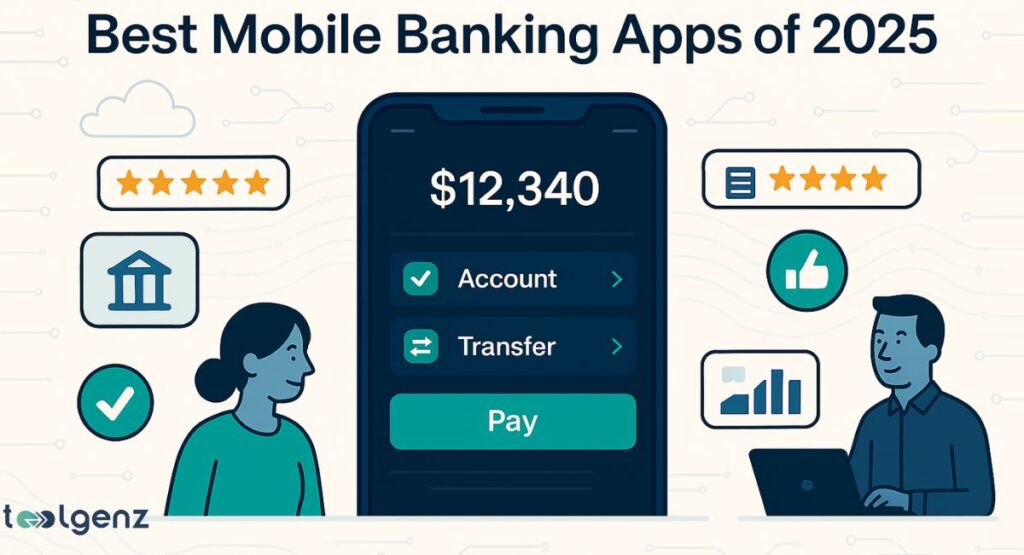
Choosing the best mobile banking app depends on your needs. Apps like Chime, SoFi, and Varo offer free accounts and smart tools.
Venmo and Simple are good for sending money and budgeting. They also support digital payment systems and have great reviews for speed and safety.
In 2025, apps are judged by how easy they are to use, how fast they work, and how safe your data is.
A good app should have biometric authentication, strong customer support, and clear features for online money transfer apps. See the table below for a quick comparison.
Additionally, consider factors like fee structures, integration with other financial services, and availability of budgeting or investment tools.
Some apps also offer cashback rewards and credit-building options that might align with your financial goals. Reading user reviews and testing apps with demo versions can help you pick the perfect fit for your lifestyle.
| App Name | Best For | Security Features | Avg. Rating |
|---|---|---|---|
| Chime | Beginners & Direct Deposit | 2FA, Alerts | 4.6/5 |
| SoFi | Loans & Investments | Biometric | 4.7/5 |
| Venmo | Quick Transfers | PIN, Alerts | 4.5/5 |
| Varo | No-Fee Banking | 2FA, Face ID | 4.4/5 |
| Simple | Budgeting | Encryption | 4.3/5 |
Opening a Digital Bank Account in Minutes: What You Need to Know
You can now open a digital bank account in just a few steps. First, download your chosen app. Then enter your name, SSN, and address.
Upload an ID for verification. Some banks use AI to approve your account in minutes. This is part of the trend of online bank account setup.
This quick setup helps many people who didn’t use banks before. It also allows faster access to services like real-time banking access and mobile check deposits.
If you’re looking to start, apps with easy setup and strong online banking security are the best choice.
Many digital banks also offer instant debit cards and budgeting tools right after account approval, helping you manage finances from day one. Plus, customer support is often available 24/7 via chat or phone to assist with any questions during the process.
Fintech Tools and Courses That Power Smarter Financial Decisions
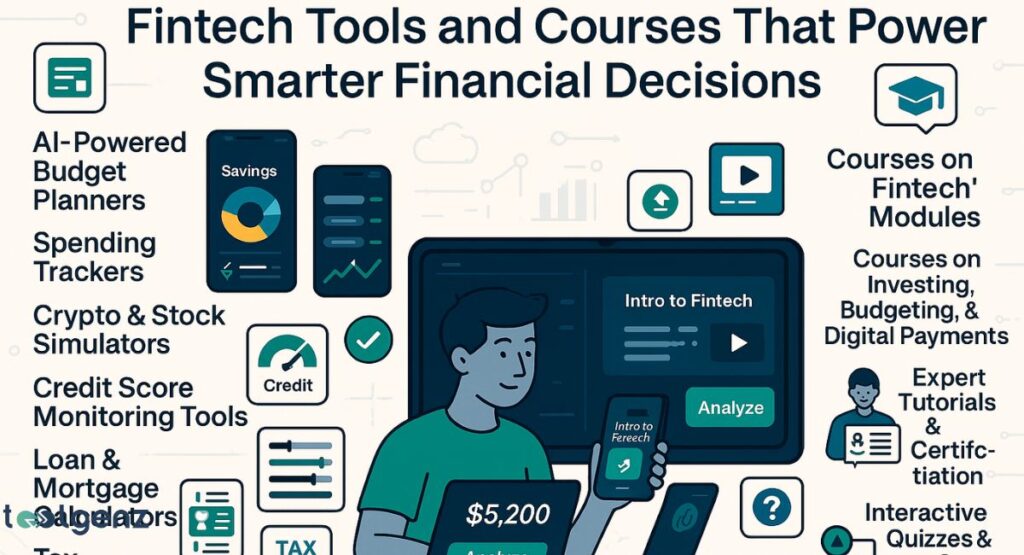
If you want to improve your money skills, try courses for mobile banking and fintech. Platforms like Udemy, Coursera, and Khan Academy offer training. These courses help you understand how to budget, save, and use new digital banking tools.
There are also mobile finance tools for real-time spending analysis, savings goals, and credit score tracking.
Learning how to track your spending using these tools can make a big difference in your money habits. These tools are useful for both individuals and businesses.
Many courses also cover topics like cybersecurity in mobile banking and how to spot fraud, helping you protect your finances in a digital world.
With consistent learning, you can take full advantage of fintech innovations to grow your financial confidence and security.
Why AML Compliance is Fintech’s Competitive Edge in 2025
Why AML compliance matters in fintech is simple. AML stands for Anti-Money Laundering.
It’s a rule to stop illegal money flow. In 2025, U.S. fintech that follow AML laws are seen as more trustworthy. They use AI to check transactions and flag risky activity.
Good AML systems protect users and stop fraud. If you’re using a fintech app, check if it follows these rules. It’s one sign that you’re working with a trusted provider. Companies that focus on AML also build better partnerships with other banks.
Beyond trust, AML compliance helps fintech’s avoid heavy fines and legal troubles. It also ensures smoother operations when dealing with global financial systems.
Staying AML compliant means fintech’s can grow safely while keeping the financial ecosystem secure for everyone.
How Real-Time Data and AI Are Disrupting Traditional Finance
Real-time data in banking is helping users make faster decisions. You get alerts the moment money moves. AI tools now give advice on what to save, when to spend, and where to invest. These features are built into many secure banking apps in 2025.
Banks also use AI to spot fraud, offer smart credit checks, and help with loans. This is changing old banking systems.
Traditional banks now compete with apps that give smarter and faster services. In short, financial technology (Fintech) is helping people take control of their money in better ways.
With real-time insights, customers can react instantly to market changes and personal spending habits.
This leads to smarter budgeting, quicker fraud detection, and personalized financial guidance that adapts as your needs evolve. The future of banking is more connected, proactive, and user-focused than ever before.
Conclusion:
Mobile banking and fintech in 2025 are changing the financial world in powerful ways. With smarter apps, better safety, and user-first features, more people are enjoying easy and safe banking.
Whether you’re a beginner or a small business owner, now is the best time to learn how to use Venmo or Simple for banking, choose the best neobanks 2024, and stay safe online. The future of money is digital—and it’s already here.
As these technologies evolve, expect even more seamless integration between financial services, personalized AI-driven advice, and faster transactions.
Staying informed and adopting these tools early will help you maximize convenience, security, and financial growth in this digital age. The money management revolution is at your fingertips—don’t miss out!
To explore more insights on digital banking trends, check out GoMyFinance’s expert tips on digital money tools.
FAQS
How does mobile banking improve user financial management?
Mobile banking improves financial management by offering real-time access to account balances, spending insights, and instant transaction alerts, helping users track and control their finances more effectively.
What financial markets does FINTECHZOOM cover extensively?
FintechZoom extensively covers global stock markets, cryptocurrencies, commodities, forex, and major financial indices like the NASDAQ and Dow Jones.
What are the key features of a modern banking app?
Modern banking apps include features like biometric authentication, mobile account monitoring, instant money transfers, budgeting tools, bill payments, and seamless online bank account setup.
What specific mobile banking features are trending?
Trending features include real-time banking access, two-factor authentication, mobile budget planning, AI-powered savings suggestions, and integration with digital payment systems.
How does Fintechzoom cover cybersecurity in banking?
FintechZoom highlights emerging cybersecurity risks in mobile banking, reports on major breaches, and promotes privacy banking features and compliance trends to keep users informed and protected.


